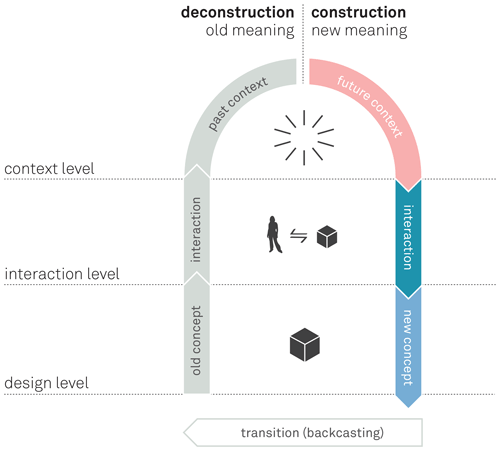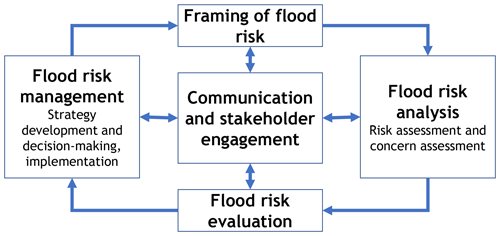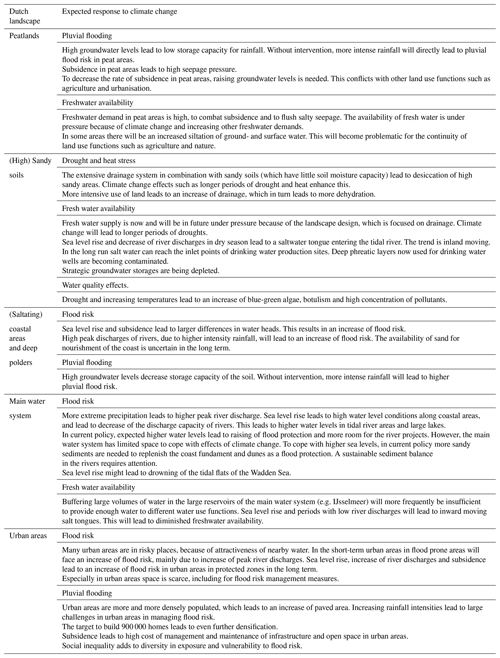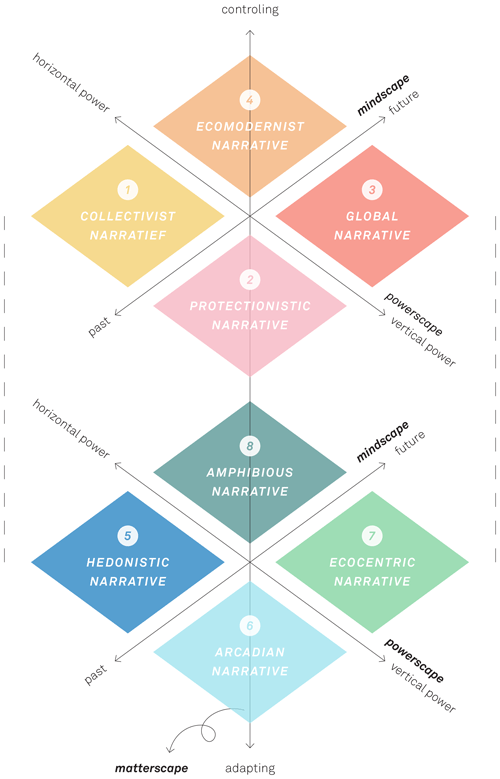the Creative Commons Attribution 4.0 License.
the Creative Commons Attribution 4.0 License.
Flood resilient landscapes: area-based solutions combine added value for society with flood risk management
Annemargreet de Leeuw
Ellen Tromp
Femke de Boer
Society faces challenges such as caring for sustainable agriculture, clean energy and restoring biodiversity, whilst developing housing and industries. Climate change meanwhile stresses the Dutch water management system, impacts flood risk management and fresh water supply. To ensure making the right decisions, which we will not regret in 100 years, we developed the concept of flood resilient landscapes. The concept of flood resilient landscapes confronts, with a perspective of long term development, desired socio-economic developments with carrying capacity and potential of underlying physical landscape conditions. The underlying principle is to create social added value while promoting or at least maintaining flood risk management, given (future) spatial and societal developments. The first results are so promising that the Dutch Flood Protection Programme aims to incorporate it. The flood resilient landscapes concept offers the prospect of keeping the Netherlands safe beyond 2100 at socially acceptable costs and with public support now and in the future and paves the way towards implementation throughout international deltas.
- Article
(3487 KB) - Full-text XML
- BibTeX
- EndNote
The Netherlands is located at the delta of rivers Rhine, Meuse and Scheldt. Two-third of the country lies below sea-level, and if it were not for an extensive flood defence system, large part would be prone to flooding by hazard of high water at sea, river or lakes (Tromp et al., 2022). In the past, the Dutch responded reactively to floods. This changed after floods of 1953 by setting legal standards to flood defences and setting up a comprehensive flood defence system. In 2008, the second Delta Commission advised to take future uncertainties into account and therefore to anticipate even more rigorously (Delta Committee, 2008). Consequently, the Dutch adopted a risk-based approach (van der Most, 2014). Because of efficiency, managing flood risk in the Netherlands is focused on strengthening flood defences. Economic risk, local individual risk and societal risk aretranslated to statutory standards in terms of signal and lowest acceptable levels of flood (or failure) probability of levees. Every 12 years the regional water authorities assess whether the levees under their mandate are still up to standard. If not, the authorities can apply for funding for improvement at the Dutch Flood Protection Programme (DFPP) (Jorissen et al., 2016). Over 1500 km of levees and over 400 structures will have to be upgraded before 2050. The magnitude of the improvement challenge forces the DFPP to focus on effectiveness (increase of production rate) and on efficiency (reduction of cost per kilometre). However, the challenge that comes with reaching the set target is especially wicked due to high level of complexity, uncertainty, and conflicting interests (Tromp et al., 2022): flood risk issues are entwined with other local problems involving diverse stakeholders, whilst the sector is institutionally fragmented, and resources are distributed in a non-hierarchical way. The ever-increasing complexity is producing new challenges and demands (Tromp et al., 2019).
The current approach to managing flood risk in the Netherlands is layed down in the Water Act, which formalises governance (responsibilities of different government institutes in relation to each other), funds, applicable flood probability standards for flood defences and cyclic reporting to parliament. A new Environment Act (expected to come in force 1 January 2024) will substitute this Water Act, by which flood defences will be treated as an integral component of rural and urban environment. This development entices a movement to scope flood risk management measures as part of a future oriented, sustainable spatial development in which value creation is key.
The complexity of planning sustainably for a future society, orientation on future, and the desire to strive for societal added value brought the following research question: How can the use of design approaches in flood risk management give a perspective to a manageable approach to face these wicked problems?
2.1 Flood risk management framing
The way the Dutch have set up their flood risk management finds its origin in recent history and consecutive policy development. It corresponds with the European Framework Directive and its underlying Floods Directive 2007/60/EC that requires member states to report on preliminary flood risk assessments, areas of potential significant flood risk and flood hazard and risk maps, and to define flood risk management plans based on this information. Like other member states, the Netherlands have not made any notable changes to their administrative arrangements (EU, 2021).
The Associated Programme on Flood risk management of the World Meteorological Organisation (APFM, 2017) provides comprehensive guidance on how to plan for flood risk management in view of the Sendai Framework for disaster risk reduction (UNDP, 2016) and is equally useful for the implementation of the Floods Directive. The document states that planning for integrated flood management is an iterative, policy-cyclic process towards risk-based decision-making with a significant role for the involvement of stakeholders (Fig. 1).
In view of finding sustainable strategies, the flood risk analysis activity in this cycle comprises the definition of future scenarios and an analysis of the response of water and soil system to these scenarios. This analysis results in a definition of the current problem, with a view on future problems because of autonomous change. We will explain more about the Dutch future situation in Sect. 3.1. The challenge that we currently face, is how to perform framing for flood risk management in a more integrative, interactive, and future resilient way. The hypothesis is that design approaches could give (part of) the answer to the wicked problem faced, by anticipating to the future, instead of focusing on today's problems and challenges.
2.2 Vision in Design
Hekkert and Van Dijk (2017) published a guidance to designing, based on a vision. They described a standard approach to define this vision, based on an understanding of the changing patterns of concerns, attitudes, and behaviours in a complex future world. Their context-driven and human-centered approach is depicted in Fig. 2. Although the method was originally developed for industrial design, in the past decade the method has proved to help organizations, communities and citizens to understand their changing environment, envision alternative futures and to develop sustainable strategies to navigate from the present into a desired future. It was investigated how this design approach could also be applicable to the societal challenge of future proof flood risk management at landscape scale.

Figure 2Following the vision in design approach of Hekkert and Van Dijk (2017), the left side of the model is the deconstruction phase, aimed at understanding the underlying values and world views behind current solutions, whereas the right side of the model shows the vision and design phase in which the aim is to develop a clear vision on the narrative(s) that can guide future goals, rules and solutions.
To this end, a desk study with additional interviews was performed to find clear and unclear, or unspoken elements that are part of our current solutions in Dutch flood risk management. In total eight experts were interviewed with expertise ranging from flood risk to delta biogeomorphology and from climate change to philosophy. A description of the current relation of Dutch society to flood risk management followed. This included a description of dominant narratives of that relation. At context level, a description of conditions and developments that led to the Dutch relation to flood risk management followed. The next level in the analysis is to find probable future narratives. A summary of the collected information can be found in Sect. 3.2.
3.1 Qualitative description autonomous response of landscaped to climate change in the Netherlands
Following the work of the Dutch Delta program, the following typical Dutch main landscapes were defined, based on water and soil characteristics. Figure 3 gives an indication where these landscapes are in the Netherlands:
-
Peatlands are located mainly in the west and north of the Netherlands. They suffer of subsidence due to drainage and oxidation of peat. The land use is mainly agriculture.
-
(High) Sandy soils are mainly located in the higher east and south of the Netherlands. Thay are well drained for agricultural and urban use. The land use is mainly agriculture, nature and urban. These soils are vulnerable for drought.
-
(Saltating) Coastal areas and deep polders are mainly located in the west and north of the Netherlands. They mostly consist of clay soil, which makes them very suitable for agriculture. These areas are vulnerable to floods and to salinization through surface- and groundwater.
-
Main water system consist of main rivers, lakes and sea. The main water system is mainly designed for fast discharge of water, whereas the lakes are increasingly in use as strategic source of fresh water.
-
Urban areas are mainly located in the west. Their drainage system is focussed on fast discharge of precipitation. High pavement rate in urban areas leads to vulnerability to flooding, drought and heat.
Climate change effects that drive responses of these landscapes are rising temperatures and dry periods, sea level rise, and intensifying precipitation. Experts on water- and soil management were challenged to specify in an expert elicitation session what emerging problems are to be foreseen for the Netherlands. The experts gave their answers under the condition of “business as usual” for land use functions.
Table 1 describes major responses, extracted from the full report of the session (Roosjen et al., 2022). To summarize: each type of landscape has their own challenge. Peat areas are susceptible to pluvial flooding and are vulnerable if too little freshwater is supplied. High sandy soils are susceptible to drought and heat stress and rely on supply of enough freshwater. Coastal areas and deep polders are vulnerable to flood risk and pluvial flooding. In the main water system, the challenge is to deliver enough discharge capacity in times of high water, and to deliver enough supply capacity in times of water shortage. Urban areas are vulnerable to both flood risk and pluvial flooding. These results correspond to other studies (Deltares et al., 2021; Schra, 2022). The question now is how much time there is before tipping points are reached and how much time is required to implement alternative pathways. Recent research showed (National Delta program, 2023) that the current flood risk strategy technically suffices to adapt to sea level rise. However, the societal willingness and acceptance of these technical measures is changing, also considering the current societal challenges the Dutch society (and worldwide on the Global North face). Recent research on decision making under deep uncertainty (Marchau et al., 2019) highlights the importance of back- and forecasting to develop strategies for e.g. freshwater supply seem to reach their tipping points earlier than flood risk management policy (National Delta program, 2023).
When focussing on flood risk, attention is drawn to peat lands, polder areas and the main water system. The situation will set boundary conditions to socio-economic development and gives direction to adaptation measures. If society wishes to maintain a current function under pressure, the function will need to adapt to new circumstances to remain feasible. The alternative is to change the land use function. And if society wishes to construct built environment in peat lands or polder areas, special attention is needed to account for long term effects to create a sustainable design.
3.2 Societal context factors
Literature with a wide perspective but related to the attitude of Dutch society to flood risk management was reviewed, with a focus on finding current and future context factors and important themes.
This first step in the Vision in Design approach, the deconstruction phase, is aimed at understanding the Why behind the world of solutions that are currently used. Based on literature and experts interviews the dominant past and current narratives underlying flood risk management in The Netherlands were explored. An important insight was that there were four repetitive narratives in Dutch society (Jensen, 2020):
- 1.
The technologic narrative tells how the Dutch created the Netherlands with hydraulic ingenuity, adaptive capacity and pioneer mind. It brings management perspective and hope, but the trust in technology also leads to being less prepared for disaster, of even to climate scepticism. This is the dominant narrative in the Netherlands today.
- 2.
The apocalyptic narrative is a story of catastrophizing. The thought that the world will decease leads on one hand to a fatalistic attitude, but on the other hand fear motivates too: We will try hard to prevent a disaster like the floods of 1953 and base our policy on incidents.
- 3.
The ecologic narrative tells us that nature is supreme and must be given the space it needs. We do not battle with water but live with water. To date stories of climate change and loss of biodiversity stimulate this narrative.
- 4.
During past ages, the secular narrative declared floods as a collective punishment of God to the sin of Man. A current variant to this narrative is that man is increasingly aware of the influence of their own behaviour to climate change.
The currently dominant technologic narrative has led to trust in technology: the Dutch landscape, flood risk management and spatial planning are considered manufacturable. This leads to low awareness with the Dutch population on flood risk related to living below sea level: the Dutch are not prepared to respond to floods.
To understand the changing societal context, literature was reviewed to collect social, cultural, economic, technological, and other developments and trends that will impact people's behaviours and attitudes with regards to flood safety. Over 180 factors were found and enriched in eight interviews with leading experts. Verification was performed in a review team.
The research team structured these factors to describe potential future attitudes to flood safety. Inspired by Jacobs (2006) three main divides were found (de Boer et al., 2022):
- 1.
Matterscape: the societal attitudes vary from belief in manufacturability to adapting to nature;
- 2.
Powerscape: dealing with (climate) change can be organised by concentrating power or by organising decentralised power in smaller communities; and
- 3.
Mindscape: in a fast-changing world people can find confidence being rooted in the past, or they trust in innovation and planning for the long term.
Realizing these three divides, eight logical narratives (Fig. 4) were constructed to represent future attitudes to flood risk management. One of these emerging narratives is the idea that water should flow rather than confining it between dikes. This ecocentric narrative is based on the idea of cooperation between “us” (humans) and “water” (sea, rivers). This might lead to more nature-based solutions and citizen participation. Likewise, seven other narratives were developed that move away from purely infrastructural flood protection. On a regional scale these narratives are used to design flood resilient landscapes.
The investigation on system boundary conditions, arising from water and soil system and challenges that come with striving for sustainable, future-oriented developments covered not only flood risk and pluvial risk issues but also drought, heat and water quality issues. Integrated water management solutions and integrated spatial developments can leverage each other, e.g. creating space for water in or near urban area will benefit mitigation of urban heat stress. The generated overview can serve as a first start for deeper investigations of potential integrative solutions.
This research revealed four categories of factors, driving change in a landscape: (1) climate change, (2) societal challenges and transitions, (3) societal attitudes and (4) challenges related to maintain a sustainable water and soil system. Until now, our research covered only societal attitudes and challenges for a sustainable water and soil system.
The research brings new perspectives to (Dutch) flood risk management forward, also to understand how “wicked” the coupling of flood risk management and integrated spatial development is. So far in practice, we see too much emphasis on short-term solutions and incremental adaptation under the assumption that climate change will be smooth sailing (Tessler et al., 2015), and therefore on a technologic narrative. Consequently, disruptive events have at best provided the “evil” tipping points to transformative change (extreme rainfall in Europe, 2021). What we need is to identify potential moments of synergy and opportunities for radical reorientation (Lenton et al., 2019) and harness them to initiate a transformative process for addressing climate change and other societal challenges. We believe that taking the values of future society into account, will ensure that the investments and decisions are no-regret. This is in line with the instruments of the decision-making under deep uncertainty (Marchau et al., 2019). From that perspective we believe that other narratives will coincide with the technologic one. Certainly, communication and stakeholder engagement will be shaped differently: instead from starting a discussion from a current flood risk management perspective the stakeholders will participate in a future value-driven approach. This will lead to a strategy that deals with all of the following: climate change, societal attitudes towards flood risk, emerging societal challenges, and sustainable ecosystem services of the natural system.
This first exploration generated insight and clarity as to what societal attitudes and perspectives towards flood risk management in the Netherlands could emerge. As such, bringing in a designer's approach already seems promising. In further experimental research the value of taking a designer's approach will be evaluated in real life pilot areas: Will it be possible to set up scoping when starting from a discussion on values in the area, on the effects of the current dominant perspective versus potentially desired narratives? Will we be able to use flood risk management as a leverage to transitions for large societal challenges vice versa, such as the transitions towards sustainable agriculture, the energy transition and housing? Which building blocks are needed to make a transition from the current situation towards a desired situation? Can we design a value-oriented, human-centered perspective and start working towards it? Are we able to define transformative pathways for future proof, integrated flood risk management in the Netherlands? In new research, we explore the application of the method further in real pilot areas. The stakeholders of these pilot areas experience the sense of urgency, and together with societal challenges this results in a window of opportunity. The flood resilient landscapes concept offers the prospect of keeping the Netherlands safe beyond 2100 at socially acceptable costs and with public support now and in the future, and paves the way towards implementation throughout international deltas, requiring strong stakeholder commitment and collaborative learning.
No data sets were used in this article.
Conceptualization: AdL. Research on autonomous response of landscapes to climate change: AdL and ET. Research on potential societal context factors: FdB. All authors contributed to the final version of the manuscript and have read and agreed to the published version.
The contact author has declared that none of the authors has any competing interests.
Publisher's note: Copernicus Publications remains neutral with regard to jurisdictional claims made in the text, published maps, institutional affiliations, or any other geographical representation in this paper. While Copernicus Publications makes every effort to include appropriate place names, the final responsibility lies with the authors.
This article is part of the special issue “ICFM9 – River Basin Disaster Resilience and Sustainability by All”. It is a result of The 9th International Conference on Flood Management, Tsukuba, Japan, 18–22 February 2023.
This research was made possible by the Strategic research funding to Deltares by the Ministry of Economic Affairs and Climate Policy and by the research funds of Knowledge for Flood Defences by the Ministry of Infrastructure and Water Management.
This research has been supported by the Rijkswaterstaat (KPP Kennis voor Keringen) and the Ministerie van Economische Zaken en Klimaat, Topconsortium voor Kennis en Innovatie (Sito to Deltares).
This paper was edited by Svenja Fischer and reviewed by two anonymous referees.
APFM (Associated Program on Flood Management): Selecting measures and designing strategies for integrated flood risk management, A Guidance Document, https://www.floodmanagement.info/publications/guidance%20-%20selecting%20measures%20and%20designing%20strategies_e_web.pdf (last access: 22 March 2024), 2017.
de Boer, F., Bizzarri, A., Gestel, M. van, Dijk, M. van, Dijk, S. van, Dijkstra, M., Oenema, A., Leeuw, A.M. de, Knoeff, H.: Future narratives in flood risk management, Part of framework flood resilient landscapes, Deltares, 50 pp., https://publications.deltares.nl/Deltares244.pdf (last access: 22 March 2024), 2022.
Delta Committee: Working together with water, a living land builds for its future, reportNational Delta Programme, 138 pp., https://english.deltaprogramma.nl/documents/publications/2008/09/03/working-together-with-water (last access: 22 March 2024), 2008.
Deltares, Bosch Slabbers and Sweco: Based on the watersystem: Boundaries to the constructability of our water- and soilsystem, report, Deltares, 50 pp., https://publications.deltares.nl/11206890.pdf (last access: 22 March 2024), 2021 (in Dutch).
EU: European Overview – 2nd Preliminary Flood Risk Assessments – Accompanying the document REPORT FROM THE COMMISSION TO THE EUROPEAN PARLIAMENT AND THE COUNCIL on the implementation of the Water Framework Directive (2000/60/EC), the Environmental Quality Standards Directive (2008/105/EC amended by Directive, 2013/39/EU) and the Floods Directive (2007/60/EC); Implementation of planned Programmes of Measures, New Priority Substances, Preliminary Flood Risk Assessments and Areas of Potential Significant Flood Risk; COM(2021) 970 final – SWD(2021) 970 final, European Commission, number COM(2021) 970 final, https://eur-lex.europa.eu/legal-content/EN/TXT/?uri=COM:2021:0970:FIN (last access: 22 March 2024), 2021.
Hekkert, P. and Van Dijk, M.: Vision in design, a guidebook for innovators, 2nd printing, BIS Publishers BV, ISBN 978-90-6369-371-8, 2017.
Jacobs, M. H.: The production of mindscapes: A comprehensive theory of landscape experience, thesis, Wageningen University, Wageningen University, ISBN 90-8504-520-7, 280 pp., https://edepot.wur.nl/40182 (last access: 22 March 2024), 2006.
Jensen, L.: The battle against water in language and picture: What stories do we tell? Narrative strategies related to water management and sea level rise, Radboud University, 48 pp., https://lottejensen.s3.amazonaws.com/uploads/spina/publication/file/980/Welke_verhalen_vertellen_we.pdf (last access: 22 March 2024), 2020 (in Dutch).
Jorissen, R., Kraaij, E., and Tromp, E.: Dutch flood protection policy and measures based on risk assessment, in: Proceedings of the 3rd European Conference on Flood Risk Management (FLOODrisk 2016), Lyon, France, 17–21 October 2016, E3S Web Conf., 7, 20016, https://doi.org/10.1051/e3sconf/20160720016, 2016.
Lenton, T. M., Rockström, J., Gaffney, O., Rahmstorf, S., Richardson, K., Steffen, W., and Schellnhuber, H. J.: Climate tipping points – too risky to bet against, Nature, 575, 592–595, https://doi.org/10.1038/d41586-019-03595-0, 2019.
Marchau, V. A. W. J., Walker, W. E., Bloemen, P. J. T. M., and Popper, S. W. (Eds.): Decision Making under Deep Uncertainty, from theory to practice, Springer International Publishing, https://doi.org/10.1007/978-3-030-05252-2, 2019.
National Delta Program: How can the Netherlands deal with sea level rise? Intermediate report of the knowledge program on sea level rise, National Delta program, 56 pp., https://www.deltaprogramma.nl/binaries/deltacommissaris/documenten/publicaties/2023/11/09/20231107-9525_tussenbalans-kennisprogramma-zeespiegelstijging_06-webversie/9525_Tussenbalans+kennisprogramma+Zeespiegelstijging_DV.pdf (last access: 22 March 2024), 2023 (in Dutch).
Roosjen, R., Niesten, M., and de Leeuw, A. M.: System Boundaries 2100, Part of framework flood resilient landscapes, Deltares, 55 pp., https://publications.deltares.nl/11208010_019_0001.pdf (last access: 22 March 2024), 2022 (in Dutch).
Schra, J., Kleinhans, M., Cohen, K., Haasnoot, M., and Middelkoop, H.: What does the Delta want?, Report 31171979, National Delta program, 43 pp., https://www.deltaprogramma.nl/binaries/deltacommissaris/ documenten/publicaties/2022/04/01/wat-wil-de-delta-neogeogra fische-kaarten-van-het-nederlandse-laagland-in-een-toekomst- met-zeespiegelstijging/20220621+WatWilDeDelta_UU_incl+ toelichtingkaarten_def.pdf (last access: 22 March 2024), 2022 (in Dutch).
Tessler, Z. D., Vörösmarty, C. J., Grossberg, M., Gladkova, I., Aizenman, H., Syvitski, J. P. M., and Foufoula-Georgiou, E.: Profiling risk and sustainability in coastal deltas of the world, Science, 349, 638–643, https://doi.org/10.1126/science.aab3574, 2015.
Tromp, E.: Enhancing Knowledge Transfer and Uptake in the Design Processes of Flood Defences, PhD thesis, Delft University of Technology, Delft, The Netherlands, https://doi.org/10.4233/uuid:df56c11b-5366-4720-9f58-015c9bf0316e, 2019.
Tromp, E., te Nijenhuis, A., and Knoeff, H.: The Dutch Flood Protection Programma: Taking innovations to the next level, Water, 14, 1460, https://doi.org/10.3390/w14091460, 2022.
UNDP: Sendai Framework for Disaster Risk Reduction (2015–2030), Preventionweb, 37 pp., https://www.preventionweb.net/files/43291_sendaiframeworkfordrren.pdf (last access: 22 March 2024), 2016.
van der Most, H., Tánczos, I., de Bruijn, K. M., and Wagenaar, D.: New Risk-based standards for flood protection in the Netherlands, in: Proceedings of the 6th International Conference on Flood Management, Sao Paulo, Brazil, 16–18 September 2014, ICFM conferences, http://eventos.abrh.org.br/icfm6/proceedings/ICFM6_Proceedings.zip (last access: 22 March 2024), 2014.









